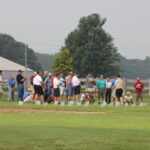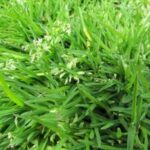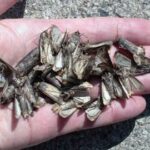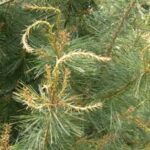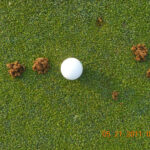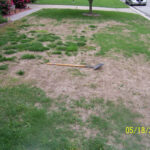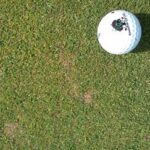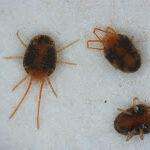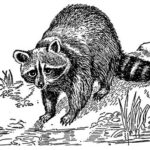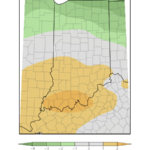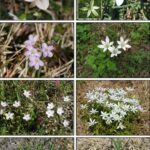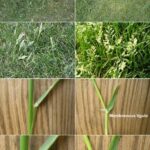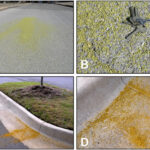Turf Tips Archives
Hot Topics at a Hot Field Day!
Thanks to all the 530 attendees and 32 exhibitors who attended the Midwest Regional Turfgrass Field Day Tuesday (July 19, 2011) at the W.H. Daniel Turfgrass Research Center in W. Lafayette, IN. We had golf and lawn research tours in the morning, two afternoon tours, and one afternoon workshop and addressed many current topics including […]
Annual bluegrass starting to succumb to summer stress in lawns
Annual bluegrass (Poa annua) is a common weed on golf courses, but is now also becoming a problem on higher mowed turf areas such as lawns and athletic fields. This grass is lighter colored than Kentucky bluegrass and perennial ryegrass and can be identified by its boat-shaped leaf tip and membranous ligule (see Turf Tip […]
Warning: High Numbers of Black Cutworms in Traps
June 28/11. We are reporting very high numbers of black cutworm moths in traps right now. These numbers are, in fact, higher than we have seen in many years. What this means to you is that there is a possibility that these moths will lay eggs on your turf and the resulting caterpillars may damage […]
Herbicide damage on Spruce and Pine – Update
A few weeks ago we posted information on herbicide damage to spruce and pine (link here). We are continuing to see some new cases of damage, but many with affected trees are simply waiting to see whether or not their trees will recover. For those of you who might have trees with suspected injury to […]
Educational Opportunity:
Educational Opportunity: Turf Field Day Tuesday, July 19, 2011 Daniel Turf Center, West Lafayette, IN Attendee Registration Form Exhibitor Registration Form Attendee On-line Registration Diagnostic Training: Lawn Care Thursday, July 28, 2011 Daniel Turf Center, West Lafayette, IN Attendee Registration Form Attendee On-line Registration
Herbicide damage on Spruce and Pine
The Plant and Pest Diagnostic Lab (PPDL) has recently received several samples of Norway spruce and white pine with symptoms that appear to be associated with injury caused by synthetic auxin (growth regulator type) herbicides. Typical off-target symptoms caused by these herbicides can include epinasty (twisting and curling) of the shoot and tips (Fig. 1) […]
Mound Making on Greens and Tees
In addition to earthworms, there are several insects that can create small mounds of soil above the surface of turfgrass. Usually such mounding is of minimal consequence and, in fact, is beneficial to turfgrass environments as it accomplishes the same thing as cultivation, aeration and top-dressing – only on a very small scale. On occasion, […]
The Case of the Dead Zoysia in Southern Indiana
Zoysia grass is a warm-season grass that is being more frequently used in warm, humid and transitional regions. As zoysia is becoming more frequent in our state we are learning more about the pests that attack it. The photograph below was taken of a stand of zoysia in the southern part of Indiana. It was […]
Drought Damage on Zoysiagrass Lawns
Last summer and fall we experienced some widespread drought throughout the state which we documented with turf tips in July, September, and November as well as tips on reestablishment this March (click here for an archive of these tips). Most were uncertain as to what the extent of the damage would be until the turf […]
Sod webworms
Sod webworms may cause damage to closely mowed turfgrass early in the spring. Damage, similar to that depicted in the photos below, may be seen on golf tees and greens. The overwintered caterpillars become active when the temperatures warm up in the spring and begin to tunnel and feed. They are mostly active at night, […]
Small Moving Specks on the Windowsill?
No you are not imagining this. The specks are actually moving. That is because they are actually tiny mites called clover mites. Clover mites can become annoying household pests, especially in and around homes where new lawns have recently been established or where there’s a heavy growth of well-fertilized grass close to foundation walls. They […]
Skunks and Raccoons causing Havoc?
We continue to receive reports of spring-time turfgrass damage caused by raccoons or skunks. These animals are not feeding on the grass but rather are foraging for below ground, high populations of white grubs. As the vertebrates forage, they turn over great clumps of turfgrass resulting in an area that resembles a war zone. Sometimes […]
Cooler Than Average Spring Temperatures for Some May Extend the Window for Preemergence Herbicide Applications
Preemergence herbicides prevent emergence of crabgrass plants. These products must be applied prior to crabgrass germination which on an average year could occur as early as April 1 in southern Indiana and three or more weeks later in northern Indiana. It is essential to apply these products early in spring prior to crabgrass germination. Last […]
Spring Beauty and Star-of-Bethlehem
Both spring beauty (Claytonia virginica) and star-of-bethlehem (Ornithogalum umbellatum) are spring flowering weeds that are similar in appearance and sometimes problematic in lawns. Below is a comparison of the two species including control recommendations for both turf professionals and homeowners. Spring Beauty (Claytonia virginica) Star-of-Bethlehem (Ornithogalum umbellatum) Description: Small perennial plant originating from corms. Leaves […]
To whom does this seedhead belong?
Kentucky bluegrass (Poa pratensis) is beginning to produce seedheads this time of year which are difficult to mow and can cause a lawn to appear uneven. However, there are other grasses such as annual bluegrass (Poa annua) that also produce similar looking seedheads. Annual bluegrass is a winter annual or weak perennial turfgrass species which […]
Spilled Fertilizer: Loading and Application
Fertilizer loading Fill spreaders over a hard surface such as a driveway, sidewalk, or other hard concrete or asphalt surface. This will allow easy clean-up if any material is spilled. Fertilizer spills over turf usually result in turf death to the affected spot. If product is spilled during loading (A), clean-up the material immediately by […]
What’s that brown spot: Nimblewill in lawns
Nimblewill (Muhlenbergia schreberi) is a weed that thin patches in lawns. Since nimblewill is a warm-season grass, it will turn brown at the first frost and is very slow to green-up in the spring. The brown patches seen in lawns in the early spring may be nimblewill contamination. This weed spreads from seeds produced and […]
Spring Grub Control Not Your Best Bet
Spring is almost upon us and overwintering white grubs will soon be emerging from the depths to continue feeding for a short time before they pupate. These overwintering grubs typically spend the frigid months of December – February deep in the soil profile (up to 12 inches deep) to avoid freezing. As soil temperatures begin […]
Part III: Controlling broadleaf weeds in newly seeded areas
This turf tip is part of a three part series on spring seeding. Most turfgrass herbicides are intended for use on established grasses. Thus, herbicide use on newly planted grasses should be very conservative. If possible, wait until the grass has gone through several mowings or a full growing season before using chemical weed control. […]
